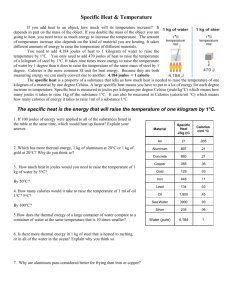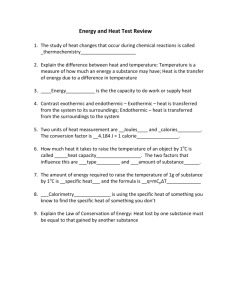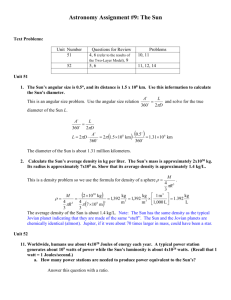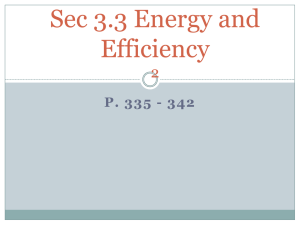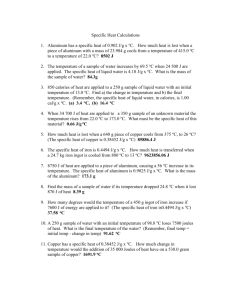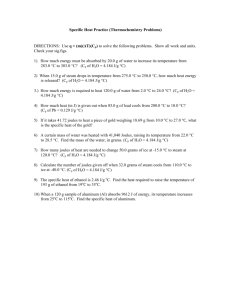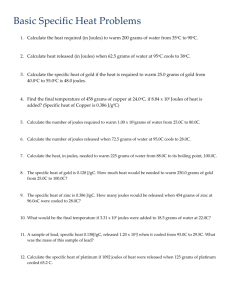Specific Heat
advertisement
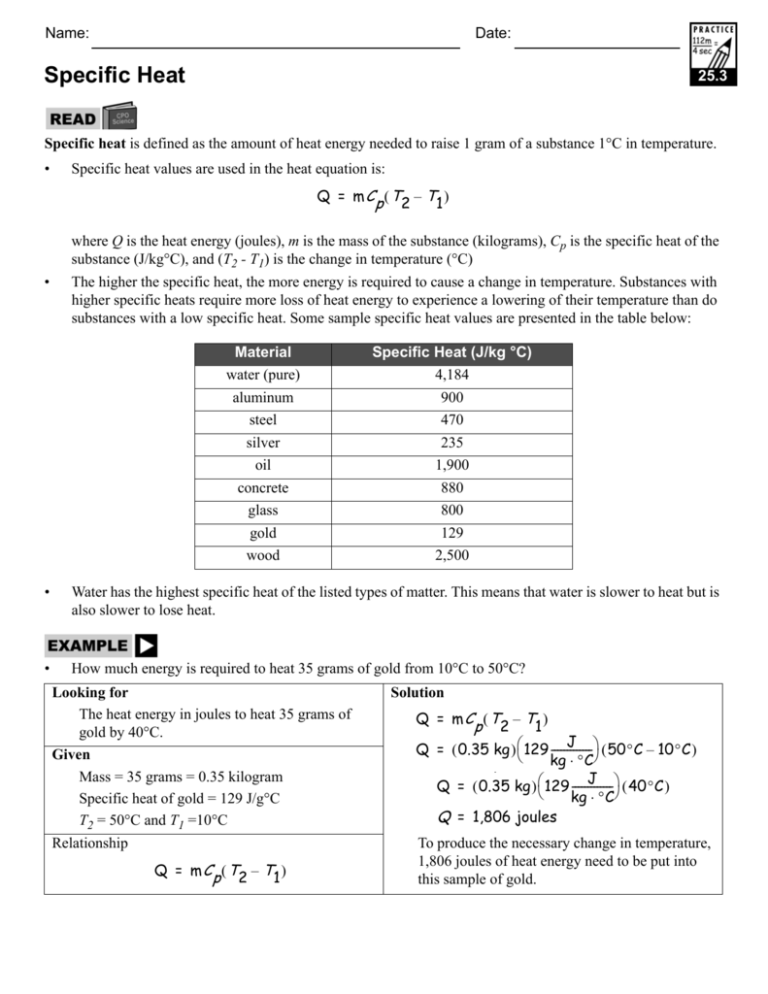
Name: Date: Specific Heat 25.3 Specific heat is defined as the amount of heat energy needed to raise 1 gram of a substance 1°C in temperature. • Specific heat values are used in the heat equation is: Q = m Cp ( T2 – T1 ) where Q is the heat energy (joules), m is the mass of the substance (kilograms), Cp is the specific heat of the substance (J/kg°C), and (T2 - T1) is the change in temperature (°C) • The higher the specific heat, the more energy is required to cause a change in temperature. Substances with higher specific heats require more loss of heat energy to experience a lowering of their temperature than do substances with a low specific heat. Some sample specific heat values are presented in the table below: Material water (pure) aluminum steel silver oil concrete glass gold wood Specific Heat (J/kg °C) 4,184 900 470 235 1,900 880 800 129 2,500 • Water has the highest specific heat of the listed types of matter. This means that water is slower to heat but is also slower to lose heat. • How much energy is required to heat 35 grams of gold from 10°C to 50°C? Looking for The heat energy in joules to heat 35 grams of gold by 40°C. Given Mass = 35 grams = 0.35 kilogram Specific heat of gold = 129 J/g°C T2 = 50°C and T1 =10°C Relationship Q = m Cp ( T2 – T1 ) Solution Q = m Cp ( T2 – T1 ) J Q = ( 0.35 kg ) ⎛ 129 -------------⎞ ( 50°C – 10°C ) ⎝ kg ⋅ °C⎠ p J Q = ( 0.35 kg ) ⎛ 129 -------------⎞ ( 40°C ) ⎝ kg ⋅ °C⎠ Q = 1,806 joules To produce the necessary change in temperature, 1,806 joules of heat energy need to be put into this sample of gold. Page 2 of 2 25.3 Using the heat formula and the table of specific heat values, solve the following heat problems. 1. A 0.5-kilogram piece of aluminum increases its temperature 7°C when heat energy is added. How much heat energy produced this change in temperature? 2. A volume of water has a mass of 0.5 kilogram. If the temperature of this amount of water was raised by 7°C, how much heat energy is produced? 3. How much heat energy is required to raise the temperature of 1 kilogram of steel by 10°C? 4. How much heat energy is needed to raise the temperature of 100-liters of water from 10°C to 25°C? Note: One liter of water has a mass of one kilogram. 5. When 1,500 joules of energy is lost from a 0.12-kilogram object, the temperature decreases from 45°C to 40°C. What is the specific heat of this object? Of what material is the object made? 6. What is the specific heat of a material that gains 600 joules of energy when a 0.25-kilogram object increases in temperate by 3°C? What is this material? 7. A liquid with a specific heat of 1,900 J/kg·°C has 4,750 joules of heat energy is added to it. If the temperature increases from 20°C to 30°C, what is the mass of the liquid? 8. What is the mass of a block of concrete that gains 52,800 joules of energy when its temperature is increased by 5°C? 9. A scientist wants to raise the temperature of a 0.10-kilogram sample of glass from –45°C to 15°C. How much heat energy is required to produce this change in temperature? 10. A person wishes to heat pot of fresh water from 20°C to 100°C in order to boil water for pasta. They calculate that their pot holds 2 kilograms of water and that they would need to apply 669,440 joules of heat energy to produce the desired temperature change. Are the person’s calculations correct? Defend your answer and demonstrate all relevant calculations. 11. A 0.25-kilogram sample of aluminum is provided with 5,000 joules of heat energy. What will be the change in temperature of this sample of aluminum? 12. What is the change in temperature for a 2-kilogram mass of water that loses 8,500 joules of energy? 13. Which of the substances listed in the table on the first page would heat up more quickly if an equal amount of heat energy were applied to all of the substances at the same time? Explain your answer. 14. Which of the substances listed in the table on the first page would you choose as the best insulator (substance that requires a lot of heat energy to experience a change in temperature)? Explain your answer. 15. Which substance—wood or steel—is the better conductor? A conductor is a material that requires very little heat energy to experience a change in temperature. Explain your answer.
